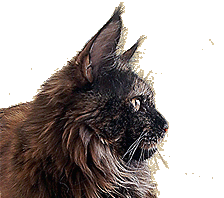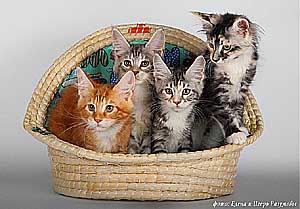 |
|
||||||||||
|
ABOUT MAINECOON BREED
The Mainecoon is a breed of domestic cat with a distinctive physical appearance. It is one of the oldest natural breeds in North America, specifically native to the state of Maine, where it is the official State Cat.
History Origin The ancestral origins of the Mainecoon are unknown. There are only theories and folk tales. One such folk tale involves Marie Antoinette, the Queen of France, who was executed in 1793. The story goes that before her death, Antoinette attempted to escape France with the help of Captain Samuel Clough. She loaded Clough's ship with her most prized possessions, including six of her favorite Turkish Angora cats. Although she did not make it to the United States, her pets safely reached the shores of Wiscasset, Maine, where they bred with other short-haired breeds and evolved into the modern breed of the Mainecoon. Another folk tale involves Captain Charles Coon, an English seafarer who kept long-haired cats aboard his ships. Whenever Coon's ship would anchor in New England ports, the felines would exit the ship and mate with the local feral cat population. When long-haired kittens began appearing in the litters of the local cat population, they were referred to as one of «Coon's cats». A theory which is biologically-based, though genetically impossible, is the idea that the modern Mainecoon descended from ancestors of semi-feral domestic cats and raccoons. This could possibly explain the most common color of the breed (brown tabby) and the bushy tail, which is a characteristic trait. Another idea is that the Mainecoon originated between the matings of domestic cats and wild bobcats, which could explain the tufts of hairs that are so commonly seen on the tips of the ears. There have been reports of domestic cats breeding with bobcats. The generally-accepted theory among breeders is that the Mainecoon is descended from the pairings of local short-haired domestic cats and long-haired breeds brought overseas by English seafarers (possibly by Captain Charles Coon) or 11th-century Vikings. The connection to the Vikings is seen in the strong resemblance of the Mainecoon to that of the Norwegian Forest Cat, another breed that is said to be a descendant of cats that traveled with the Vikings. The first mention of Mainecoons in a literary work was in 1861, when a black-and-white Mainecoon by the name of Captain Jenks of the Horse Marines was written about by co-owner F.R. Pierce, who wrote a chapter about the breed in Frances Simpson's The Book of the Cat (1903) and owned several other Mainecoons. During the late 1860s, farmers located in Maine told stories about their cats and held the «Maine State Champion Coon Cat» contest at the local Skowhegan Fair.
In 1895,
a dozen Mainecoons were entered into a show in Boston, USA. On May
8, 1895, the first North American cat show was hosted at Madison
Square Garden in New York City. A female Mainecoon brown tabby,
named Cosey, was entered into the show. Owned by Mrs. Fred Brown,
Cosey won the silver collar and medal and was named Best in Show.
The silver collar was purchased by the Cat Fanciers' Association
(CFA) Foundation with the help of a donation from the National
Capital Cat Show. The collar is housed at the CFA Central Office in
the Jean Baker Rose Memorial Library. The Mainecoon was denied provisional breed status – one of the three steps required for a breed not yet recognized by the CFA to be able to compete in championship competitions—by the CFA three times, which led to the formation of the Mainecoon Cat Club in 1973. The breed was finally accepted by the CFA under provisional status on May 1, 1975, and was approved for championship status on May 1, 1976. The next couple of decades saw a rise in popularity of the Mainecoon, with championship victories and an increase in national rankings. In 1985, the state of Maine announced that the breed would be named the official State Cat. The Mainecoon is the second most popular cat breed, according to the amount of kittens registered with the CFA. Breed description Mainecoons are one of the largest breeds of domestic cat. Males weigh anywhere between 15 and 25 lb (6.8 and 11 kg) with females weighing between 10 and 15 lb (4.5 and 6.8 kg). The height of adults can vary between 10 and 16 in (25 and 41 cm) and they can reach a length of up to 40 in (100 cm), including the tail, which can reach lengths of up to 14 in (36 cm) and is long, tapering, and heavily furred, almost resembling a raccoon's tail. The body is solid and muscular, which is necessary for supporting their own weight, and the chest is broad. Mainecoons possess a rectangular body shape and are slow to physically mature; their full potential size is normally not reached until they are around three or four years old. In 2006, the Guinness World Records named a male purebred Mainecoon the «Longest Cat». Verismo Leonetti Reserve Red (better known as Leo) measures 48 in (120 cm) in length, from the tip of his nose to the tip of his tail, and weighs 35 lb (16 kg). Leo was the only kitten in his litter and was sired by a large dam Musicoons Tippy Tina of Verismo, and his sire was Musicoons The Cisco Kid of Verismo. Both parents were quite large, and given that Leo had all of his mother's milk, this may have been what allowed him to grow to such a great size. The Mainecoon is a longhaired, or medium-haired, cat. The coat is soft and silky, although texture may vary with coat color. The length is shorter on the head and shoulders, and longer on the stomach and flanks with some cats having a lion-like ruff around their neck. Minimal grooming is required for the breed, compared to other long-haired breeds, as their coat is mostly self-maintaining due to a light-density undercoat. The coat is subject to seasonal variation, with the fur being thicker in the winter and thinner during the summer. Mainecoons, due to their large size, have larger claws. There have been cases of Mainecoons using their claws to grip into walls. Mainecoons can have any colors that other cats have. Colors indicating hybridization, such as chocolate, lavender, the Siamese pointed patterns or the «ticked» patterns, are unaccepted by breed standards. The most common color seen in the breed is brown tabby. All eye colors are accepted under breed standards, with the exception of the occurrence of blue-colored or odd-eyes (i.e., two eyes of different colors) in cats possessing coat colors other than white. Mainecoons have several physical adaptations for survival in harsh winter climates. Their dense water-resistant fur is longer and shaggier on their underside and rear for extra protection when they are walking or sitting on top of wet surfaces of snow or ice. Their long and bushy raccoon-like tail is resistant to sinking in snow, and can be curled around their face and shoulders for warmth and protection from wind and blowing snow and it can be even curled around their backside like a insulated seat cushion when sitting down on a snow or ice surface. Large paws, and especially the extra-large paws of polydactyl Mainecoons, facilitate walking on snow and are often compared to snowshoes. Long tufts of fur growing between their toes help keep the toes warm and further aid walking on snow by giving the paws additional structure without significant extra weight. Heavily furred ears with extra long tufts of fur growing from inside help keep their ears warm.
Mainecoons are known as the «gentle giants» and possess above-average intelligence, making them relatively easy to train. They are known for being loyal to their family and cautious—but not mean—around strangers, but are independent and not clingy. The Mainecoon is generally not known for being a «lap cat» but their gentle disposition makes the breed relaxed around dogs, other cats, and children. They are playful throughout their lives, with males tending to be more clownish and females generally possessing more dignity, yet both are equally affectionate. Many Mainecoons have a fascination with water and some theorize that this personality trait comes from their ancestors, who were aboard ships for much of their lives. |
|||||||||||
|
Copyright © 2010, Web-site of «Tassel Magic» Mainecoon cattery • www.m-tassel.narod.ru • Saransk, Russia |
|||||||||||


